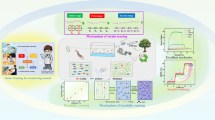Abstract
This paper introduces a kind of silicon-based dry electrode for measuring biological signals. It uses microneedle arrays to penetrate into the stratum corneum to reduce skin impedance. The dry electrode requires neither skin preparation nor the electrolytic gel, is easy to use and causes no skin allergy. Two different technologies are chosen to manufacture microneedle arrays of dry electrode. One is deep dry etching combined with isotropic wet etching. The other is mechanical dicing combined with chemical wet etching (including isotropic wet etching and anisotropic wet etching). Microneedle arrays are coated with metal and divided into 25 mm2 as dry electrode patch. Impedance testing shows that the impedance value of dry electrode can be comparable with that of commercial electrode in the 20 Hz-10 kHz frequency range. The steady-state visual evoked potential recording and analysis prove that the dry electrode can be used to detect electroencephalography.
Similar content being viewed by others
References
Matteucci M, Carabalona R, Casella M, et al. Micropatterned dry electrodes for brain-computer interface. Microelectron Eng, 2007, 84: 1737–1740
Griss P, Enoksson P, Tolvanen-Laakso H K, et al. Micromachined electrodes for biopotential measurements. J Microelectromech S, 2001, 10: 10–16
Griss P, Tolvanen-Laakso H K, Merilainen P, et al. Characterization of micromachined spiked biopotential electrodes. IEEE Trans Bio-med Eng, 2002, 49: 597–604
Baek J, An J, Choi J, et al. Flexible polymeric dry electrodes for the long-term monitoring of ECG. Sensor Actuat A: Phys, 2008, 143: 423–429
Yu L M, Tay F, Guo D G, et al. A microfabricated electrode with hollow microneedles for ECG measurement. Sensor Actuat A: Phys, 2009, 151: 17–22
Henry S, McAllister D V, Allen M G, et al. Micromachined needles for the transdermal delivery of drugs. In: Annual of International Conference on IEEE Microelectromech System. Germany: Heidelberg, 1998. 494–498
Ruffini G, Dunne S, Farres E, et al. A dry electrophysiology electrode using CNT arrays. Sensor Actuat A: Phys, 2006, 132: 34–41
Mukerjee E, Collins S, Isseroff R, et al. Microneedle array for transdermal biological fluid extraction and in situ analysis. Sensor Actuat A: Phys, 2004, 114: 267–275
Rajaraman S, Henderson H T. A unique fabrication approach for microneedles using coherent porous silicon technology. Sensor Actuat B: Chem, 2005, 105: 443–448
Wilke N, Hibert C, O’Brien J, et al. Silicon microneedle electrode array with temperature monitoring for electroporation. Sensor Actuat A: Phys, 2005, 123–124: 319–325
Wilke N, Mulcahy A, Ye S R, et al. Process optimization and characterization of silicon microneedles fabricated by wet etch technology. Microelectron J, 2005, 36: 650–656
Chandrasekaran S, Frazier A B. Characterization of surface micromachined metallic microneedles. J Microelectromech S, 2003, 12: 289–295
Parker E R, Rao M P, Turner K L, et al. Bulk micromachined titanium microneedles. J Microelectromech S, 2007, 16: 289–295
Aoyagi S, Izumi H, Isono Y, et al. Laser fabrication of high aspect ratio thin holes on biodegradable polymer and its application to a microneedle. Sensor Actuat A: Phys, 2007, 139: 293–302
Han M, Kim D K, Kang S H, et al. Improvement inantigen-delivery using fabrication of a grooves-embedded microneedle array. Sensor Actuat B: Chem, 2009, 137: 274–280
Moon S J, Lee S S, Lee H S, et al. Fabrication of microneedle array using LIGA and hot embossing process. Microsyst Technol, 2005, 11: 311–318
Park J H, Yoon Y K, Choi S O, et al. Tapered conical polymer microneedles fabricated using an integrated lens technique for transdermal drug delivery. IEEE Trans Bio-med Eng, 2007, 54: 903–913
Ladenburger A, Reiser A, Konle J, et al. Regular silicon pillars and dichroic filters produced via particle-imprinted membranes. J Appl Phys, 2007, 101: 034302–034302-5
Norazreen A A, Muhamad R B, Burhanuddin Y M. Process characterization of wet etching for high aspect ration microneedles development. Adv Mater Res, 2009, 74: 341–344
Campbell P K, Jones K E, Huber R J, et al. A silicon-based, 3-dimensional neural interface: manufacturing processes for an intracortical electrode array. IEEE Trans Bio-med Eng, 1991, 38: 758–768
Shikida M, Hasada T, Sato K. Fabrication of a hollow needle structure by dicing, wet etching and metal deposition. J Micromech Microeng, 2006, 16: 2230–2239
Resnik D, Vrtacnik D, Aljancic U, et al. Different aspect ratio pyramidal tips obtained by wet etching of (100) and (111) silicon. Microchem J, 2003, 34: 591–593
Wilke N, Morrissey A. Silicon microneedle formation using modified mask designs based on convex corner undercut. J Micromech Microeng, 2007, 17: 238–244
Cheng X, Gao X, Gao S K, et al. Design and implementation of a brain-computer interface with high transfer rates. IEEE Trans Bio-med Eng, 200, 49: 1181–1186
Author information
Authors and Affiliations
Corresponding author
Rights and permissions
About this article
Cite this article
Wang, Y., Pei, W., Guo, K. et al. Dry electrode for the measurement of biopotential signals. Sci. China Inf. Sci. 54, 2435–2442 (2011). https://doi.org/10.1007/s11432-011-4354-0
Received:
Accepted:
Published:
Issue Date:
DOI: https://doi.org/10.1007/s11432-011-4354-0




